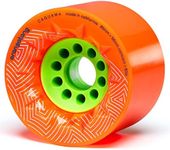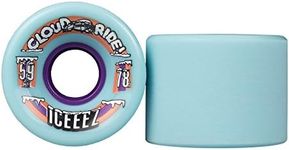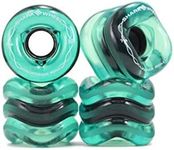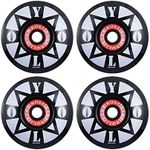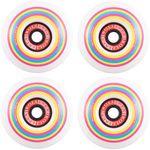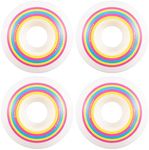Buying Guide for the Best Longboard Wheels
Choosing the right longboard wheels is crucial for optimizing your riding experience. The wheels you select can significantly impact your speed, stability, and overall performance. To make an informed decision, it's important to understand the key specifications and how they relate to your riding style and needs.DiameterThe diameter of longboard wheels is measured in millimeters (mm) and typically ranges from 60mm to 100mm. Smaller wheels (60-70mm) are lighter and provide quicker acceleration, making them ideal for technical tricks and cruising on smooth surfaces. Medium-sized wheels (70-85mm) offer a balance between speed and maneuverability, suitable for general cruising and carving. Larger wheels (85-100mm) are best for downhill riding and rough terrains as they maintain higher speeds and roll over obstacles more easily. Choose the diameter based on your primary riding style and the surfaces you'll be riding on.
DurometerDurometer measures the hardness of the wheels and is indicated by a number followed by the letter 'A' (e.g., 78A). Softer wheels (75A-80A) provide better grip and a smoother ride, making them suitable for cruising and carving. Medium hardness (81A-87A) offers a balance of grip and slide, ideal for freeriding and general use. Harder wheels (88A-101A) are more durable and slide easily, preferred for sliding and technical tricks. Consider the durometer based on the type of riding you plan to do and the level of grip you need.
Contact PatchThe contact patch is the area of the wheel that makes contact with the ground. A wider contact patch provides more grip and stability, which is beneficial for downhill riding and carving. A narrower contact patch allows for easier sliding and quicker turns, making it suitable for freeriding and technical tricks. Determine the contact patch width based on your need for grip versus slide and the type of riding you enjoy.
Wheel ShapeLongboard wheels come in various shapes, including square-lipped and round-lipped. Square-lipped wheels have sharp edges that provide maximum grip, ideal for downhill and carving. Round-lipped wheels have rounded edges that make sliding easier, suitable for freeriding and technical tricks. Choose the wheel shape based on whether you prioritize grip or the ability to slide.
Core PlacementThe core placement of a wheel can be center-set, side-set, or offset. Center-set cores are positioned in the middle of the wheel, offering a balanced ride and even wear, suitable for all-around use. Side-set cores are placed closer to the inside edge, providing more grip and easier sliding, ideal for freeriding. Offset cores are between center-set and side-set, offering a mix of grip and slide, making them versatile for various riding styles. Select the core placement based on your preference for grip and slide characteristics.

